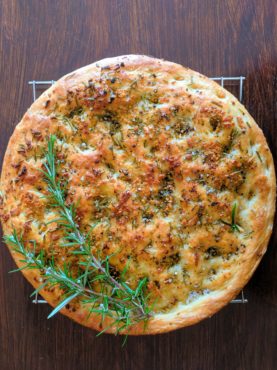An uninteresting and intermittent cooking column
Are you interested in making friends by implementing your half-assed baking ability? No? Too bad, because you’ll be making them one way or another when your friends-to-be detect the delectable scent of this focaccia bread. This recipe is written for inexperienced bakers, because any self-respecting professional baker wouldn’t be following the advice of a second-year Economics student anyway.
So, sit down, dust off the apron you don’t own because you’re an amateur, and head out to the supermarket because there’s no way your incompetent ass has all of these ingredients.

- 3 cups flour (you can use whole grain, but I’d bet your pallet isn’t ready for it)
- 2 tbsp brown sugar
- 1 cup water (room temperature to warm)
- 1 tsp table salt
- 1.5 tsp yeast
- 12 garlic cloves or however much you want, really – 4 minced for the dough, 8 minced for topping the focaccia.
- 2 sprigs of chopped fresh rosemary or 2 tbsp dried (not powdered) rosemary
- 1 sprig of chopped fresh thyme or 1 tbsp dried (not powdered) thyme
- Peppercorns, crushed with the flat of a knife
- Sea salt/flake salt (to taste)
- ½-¾ cup olive oil
Step 1: The initializing: ~15 minutes
Take the water, yeast, table salt, and sugar and put it into a large-ish bowl. Let it sit until the yeast, sugar, and salt have dissolved and the yeast begins to eat the sugar, resulting in a light foaming on top of the liquid. The water should be the temperature that you could leave your hand in for a minute without feeling uncomfortable. If it burns you, it’ll kill the yeast, and if it numbs you, you’ll have to wait a long time for the yeast to be active. If you do it right you shouldn’t have to wait more than like 15 minutes. If nothing happens at all, you might just be using dead yeast. RIP.
Step 2: Mixing and folding: ~10 minutes
Take your flour and sift it into the bowl, add about a third of your minced garlic (like four cloves), and using a spatula, combine until you have a mess of partly mixed excuse-for-dough. You’ll add the rest of the garlic later for the topping, so be sure to save it. Or don’t. I don’t care what you do. Once you’re done you can take the dough and make a hat out of it if you want. It’s your dough, buddy.
Anyway — take all of the stuff you half-assedly mixed and put it onto an unfloured non-porous surface, and fold for five minutes until it’s homogenous. Now your dough should be somewhat elastic but moist. If not, then you should add a little water. If it feels like you’re handling a dead jellyfish, then you should add a little flour. Just like every bread recipe ever.
Step 3: Leave it alone: ~1 hour
Yup. That’s it. Cover it with a clean damp washcloth and let it sit in a warm place for like an hour. On top of your refrigerator is a great place, if you’re unimaginative.
Step 3.5: Leaving it again, just like how everyone leaves you: ~0 to 48 hours
This is actually what makes this recipe fantastic. Cover your dough with something airtight, and put it in the fridge for up to two days before cooking. This will make your dough taste better, and also give you the opportunity to prep the night before family brunch, a dinner party, or when you’re binge watching Friends by yourself. I know that you’ll be eating this whole thing alone. Let’s pretend I didn’t acknowledge it.
If you end up refrigerating it at all, be sure to let it warm up before attempting to shape it.
Step 4: Oh god you’re going to have to try your hand at baking the damn thing: ~35 minutes

Set your oven to 175 degrees Celsius (350 Fahrenheit if you’re a fucking Yankee and pronounce it like “Z” instead of “Z”) and grab your dough and something to cook it in. I use a cast iron pan because it cooks evenly but honestly any sort of oven safe dish with a lip will do. Your dough will rise a bit, so it’s totally possible that the oil will overflow if the lip of the dish is too short. Which is bad, by the way.
In any case, coat your baking tray or whatever you’re using lightly with olive oil. Shape your dough into a ball and place it into the centre of the pan, stabbing it ruthlessly with your fingers to spread it out and create more surface area for the oil to be absorbed through. Now for the topping. Take your garlic, pepper, rosemary, thyme, and sea salt and rub it into the top of the dough like you would rub seasoning into a chicken. This is important to do before adding most of the oil, or none of the toppings will stick. Now add the rest of the olive oil, covering the surface of the dough with it. Be gentle when pouring, or you’ll dislodge the toppings. Since you’re clumsy as all hell, you should pour it from your measuring cup onto a spoon that you’re holding overtop of the dough. Make sure the entire surface is covered. Now put it into the oven. It should take 20 minutes, depending on the accuracy of your oven’s heat setting.
Step 5: Eat it:
Eat it.
FAQs
When is it done?
It’s done when the bottom is crispy and caramel coloured, and you can tilt it on one side without seeing the centre sag. As long as it isn’t raw or charred you’re good to go, though.
Why does it look like a tasty island floating in a sea of oil?
If you’re noticing that the olive oil has stopped being absorbed, temporarily remove your bread from the oven and spoon out excess oil. If it looks dry, add more.
Why does it have the consistency of a brick?
The bubbles formed in bread are from water in the dough steaming up and expanding, so if your dough ends up being way too firm for your liking, add a little water next time. For now I’d say chuck it if you won’t eat it. This recipe isn’t that expensive to make.
Why does it look green?
If you pay attention, you’ll notice that the oil is getting sucked up by the bread, making it turna sort of gold-green. That’s good, and it won’t stay greenish for more than like two minutes. If it stays like that you might just be using some weird-ass oil.
Why has my cooking pan opened up a portal into an otherworldly realm, showing a window into a fiery hellscape?
You’ve added too much salt and accidentally summoned a door to Tor’me’agoreath, home to the four hounds of Aioeu. Don’t panic, and pay your respects to Martauug, the Gatekeeper of Tor’me’agoreath. If you’re lucky, your sign will be in retrograde and he will take pity on you and close the gate. Whatever you do, don’t throw water on the pan, because you might start a grease fire. That would really just lengthen the list of things you have to deal with.
Thanks for reading! If you enjoyed this article and would like to make sure we keep writing articles like it, please consider supporting us on the Martlet 70 fundraiser’s GoFundMe page.
If you hated the article, though, you should still donate to the GoFundMe page (so we can hire better writers).








